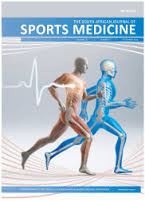The South African Rugby Injury and Illness Surveillance and Prevention Project (SARIISPP): SARU Girls’ Youth Week Injury Surveillance Report 2019
DOI:
https://doi.org/10.17159/2078-516X/2021/v33i1a12487Abstract
As part of the South African Rugby Injury and Illness Surveillance and Prevention Project (SARIISPP), the annual SARU Youth Week tournaments’ injury data are recorded and investigated by SA Rugby. The BokSmart National Rugby Safety Programme has been collecting and analysing these data annually since 2011 for the SARU Boy’s Youth Week tournaments. In 2015, the SARU Girls’ Youth Week data collection began; this report being the first to analyse the Girls’ Youth Week data.
The analysis shows injury patterns over time between tournaments, and collectively, for the girls’ u16 and u18 SARU Youth Weeks. Additionally, the analysis compares the profiles of injured players at each individual tournament. When investigating these patterns, areas of concern are identified, changes in the game, tournament structure or medical support services are considered or contested against the evidence, and injury specific interventions can be created and implemented, where the evidence indicates such a need.
Each medical facility at the SARU Youth Week tournaments has a designated researcher onsite, who together with the tournament medical doctors, records the tournament injury data daily. Three injury cases were removed from the analysis. These data were recorded but did not appear to be accurate on follow-up and were therefore removed. Unfortunately, inaccuracy can occur during data collection and measures have been implemented to ensure that this is limited.
This 2019 SARU Girls’ Youth Week report focuses on the Girls’ tournaments, comprising of the Girls u16 Week (Gu16W) and Girls u18 Week (Gu18W) held in 2019. The tournaments consisted of 32 teams and 48 matches. Comparisons are made between SARU Girls’ Youth Week tournaments and over time between 2015 and 2019. It must be noted that no Gu16W tournament was held in 2017.
In 2019, the Gu16W recorded a higher Time-Loss injury incidence at 22 (11 - 33) [mean (95% confidence intervals)] injuries per 1000 player hours. Gu18W recorded slightly lower Time-Loss injury incidence at 19 (10 – 28) injuries per 1000 player hours. The collective tournament average was measured at 21 (13 to 28) injuries per 1000 player hours. When combining the injury incidence data collected over the five years, Gu18W had a lower Time-Loss injury incidence.
In 2019, the Tackler and Open Play, followed by the Ball Carrier, were the most frequent injury-causing events in that order. Tackling front-on (regulation), Tackling LOW side-on, and Tackling LOW front-on, were the most frequent injury causing mechanisms involved in the Tackler phases of play. While Collision in Open Play was the most frequent injury causing mechanism in Open Play.
The most common injury type was Central Nervous System injuries, where Gu18W recorded a higher incidence. Head and Neck were the most common injury locations in 2019, accounting for 69% of the injuries, with most of these injuries occurring in the Gu18W. Scrumhalves and flyhalves were the player positions with the highest normalised injury incidence per player per position across all tournaments.
As expected, the injury incidence of ‘New’ injuries was higher than subsequent ‘Recurrent’ injuries. The majority of ‘New’ injuries were injuries to the joint, while most ‘Recurrent’ injuries were ligament and joint injuries.
Fourteen concussions occurred across the two tournaments in 2019, which has dropped since the spike recorded in 2018. The Gu18W had the higher concussion incidence of the two tournaments. Furthermore, the act of Tackling contributed to 50% of the events causing concussions.
The tackle contest is clearly an event that requires additional injury prevention focus for coaches on preparing their younger female players better for rugby, and requires more time spent on teaching them safer techniques and body positions in the tackle contest.
Downloads
Downloads
Published
Issue
Section
License
Copyright (c) 2021 South African Journal of Sports Medicine

This work is licensed under a Creative Commons Attribution 4.0 International License.
The South African Journal of Sports Medicine reserves copyright of the material published. The work is licensed under a Creative Commons Attribution 4.0 (CC BY 4.0) International License. Material submitted for publication in the South African Journal of Sports Medicine is accepted provided it has not been published elsewhere. The South African Journal of Sports Medicine does not hold itself responsible for statements made by the authors.
How to Cite
- Abstract 453
- PDF 401






.png)